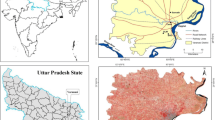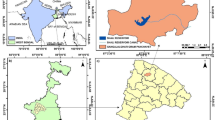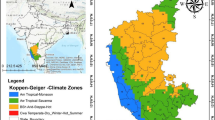Abstract
This study assesses the sensitivity of Land Use Land Cover (LULC) representation on the evolution of mesoscale convective systems over Bhubaneswar, a rapidly growing city (~ 77% growth in the last two decades) in India. In this study, three types of LULC maps have been prepared using supervised machine learning (ML) methods such as Classification and Regression Trees (CART), Naive Bayes (NB), and Support Vector Machine (SVM) on Google Earth Engine (GEE) platform using Landsat 8 for 2014. A high accuracy score (87%) and kappa coefficient (84%) revealed the best performance of CART in generating the LULC map. The Weather Research and Forecasting (WRF) model at 6 and 2 km horizontal resolution is forced with these LULC maps. Model results highlight that the CART experiment exhibits relatively less bias in 2 m relative humidity (~ – 10% to – 5%), 2 m temperature (~ 2.5 °C to ~ 0 °C), and 10 m wind speed (– 1 to ~ 1.8 m s−1) up to peak stage of the thunderstorms. The CART performs better with less rainfall error (~ – 16 mm) than CNTL (~ – 33 mm), NB (~ – 37 mm), and SVM (~ – 38 mm) and is supported by the quantitative statistical analysis, viz. less false alarm ratio, critical success index for different thresholds. LULC class-wise analysis indicates a higher variation in surface and lower atmospheric parameters over urban, shrubland, and cropland while less variation over barren, forest, and water. Thus, the study highlights the credibility of ML models in representing LULC information to input the high-resolution models.









Similar content being viewed by others
Data and material availability
The data that support the findings of this study are available from the corresponding author upon reasonable request.
Code availability
The numerical modeling code and the data used are freely available and accessible.
References
Ahmed S, Bharat A (2012) Wind field modifications in habitable urban areas. Curr World Environ 7(2):267
Anasuya B, Swain D, Vinoj V (2019) Rapid urbanization and associated impacts on land surface temperature changes over Bhubaneswar Urban District India. Environ Monit Assess 191(3):1–13
Bhardwaj P, Singh O, Kumar D (2017) Spatial and temporal variations in thunderstorm casualties over India. Singap J Trop Geogr 38(3):293–312
Bhavana M, Gupta K, Pal PK, Kumar AS, Gummapu J (2018) Evaluation of high resolution urban LULC for seasonal forecasts of urban climate using WRF model. ISPRS Ann Photogramm, Remote Sens Spat Inf Sci 4:303–310
Bishop CM (2006) Pattern recognition and machine learning. Springer, New York, NY
Bornstein R, Lin Q (2000) Urban heat islands and summertime convective thunderstorms in Atlanta: three case studies. Atmos Environ 34(3):507–516
Breiman L (1996) Bagging predictors. Mach Learn 24(2):123–140
Cheng FY, Hsu YC, Lin PL, Lin TH (2013) Investigation of the effects of different land use and land cover patterns on mesoscale meteorological simulations in the Taiwan area. J Appl Meteorol Climatol 52(3):570–587
Copernicus climate change service (C3S) (2017) ERA5: Fifth generation of ECMWF atmospheric reanalyses of the global climate. copernicus climate change service climate data store (CDS), 2018/12. Available at: https://cds.climate.copernicus.eu/cdsapp# !/home
Ebert EE, Janowiak JE, Kidd C (2007) Comparison of near-real-time precipitation estimates from satellite observations and numerical models. Bull Am Meteor Soc 88(1):47–64
Foody GM, Mathur A (2004) A relative evaluation of multiclass image classification by support vector machines. IEEE Trans Geosci Remote Sens 42(6):1335–1343
Gharai B, Rao PVN, Dutt CBS (2018) Mesoscale model compatible IRS-P6 AWiFS-derived land use/land cover of Indian region. Curr Sci 115(12):2301–2306
Gogoi PP, Vinoj V, Swain D, Roberts G, Dash J, Tripathy S (2019) Land use and land cover change effect on surface temperature over Eastern India. Sci Rep 9(1):1–10
Gomes VC, Queiroz GR, Ferreira KR (2020) An overview of platforms for big earth observation data management and analysis. Remote Sens 12(8):1253
Göndöcs J, Breuer H, Pongrácz R, Bartholy J (2017) Urban heat island mesoscale modelling study for the Budapest agglomeration area using the WRF model. Urban Clim 21:66–86
Gorelick N, Hancher M, Dixon M, Ilyushchenko S, Thau D, Moore R (2017) Google earth engine: planetary-scale geospatial analysis for everyone. Remote Sens Environ 202:18–27
Halder S, Saha SK, Dirmeyer PA, Chase TN, Goswami BN (2016) Investigating the impact of land-use land-cover change on Indian summer monsoon daily rainfall and temperature during 1951–2005 using a regional climate model. Hydrol Earth Syst Sci 20(5):1765–1784
Hall SJ, Learned J, Ruddell B, Larson KL, Cavender-Bares J, Bettez N, Groffman PM, Grove JM, Heffernan JB, Hobbie SE, Morse JL, Trammell TLE (2016) Convergence of microclimate in residential landscapes across diverse cities in the United States. Landsc Ecol 31(1):101–117
Hou AY, Kakar RK, Neeck S, Azarbarzin AA, Kummerow CD, Kojima M, Oki R, Nakamura K, Iguchi T (2014) The global precipitation measurement mission. Bull Am Meteorol Soc 95(5):701–722
John GH, and Langley P (1995) Estimating continuous distributions in bayesian classifiers. in proceedings of the eleventh conference on uncertainty in artificial intelligence
Kavzoglu T, Colkesen I (2009) A kernel functions analysis for support vector machines for land cover classification. Int J Appl Earth Obs Geoinf 11(5):352–359
Khan MFA, Muhammad K, Bashir S, Ud Din S, Hanif M (2021) Mapping allochemical limestone formations in Hazara, Pakistan using google cloud architecture: application of machine-learning algorithms on multispectral data. ISPRS Int J Geo Inf 10(2):58
Killough B (2018, July). Overview of the open data cube initiative. In IGARSS 2018–2018 IEEE international geoscience and remote sensing symposium (pp. 8629–8632). IEEE
Kuncheva LI (2006) On the optimality of Naïve Bayes with dependent binary features. Pattern Recogn Lett 27(7):830–837
Lal P, Shekhar A, Kumar A (2021) Quantifying temperature and precipitation change caused by land cover change: a case study of India using the WRF model. Front Environ Sci 9:1–14, 766328. https://doi.org/10.3389/fenvs.2021.766328
Lawrence RL, Wright A (2001) Rule-based classification systems using classification and regression tree (CART) analysis. Photogramm Eng Remote Sens 67(10):1137–1142
Li X, Mitra C, Dong L, Yang Q (2018) Understanding land use change impacts on microclimate using weather research and forecasting (WRF) model. Phys Chem Earth, Parts a/b/c 103:115–126
Lin CY, Chen WC, Chang PL, Sheng YF (2011) Impact of the urban heat island effect on precipitation over a complex geographic environment in northern Taiwan. J Appl Meteorol Climatol 50(2):339–353
Litta AJ, Mohanty UC, Idicula SM (2012) The diagnosis of severe thunderstorms with high-resolution WRF model. J Earth Syst Sci 121(2):297–316
Litta AJ, Mohanty UC (2008) Simulation of a severe thunderstorm event during the field experiment of STORM programme 2006, using WRF–NMM model. Curr Sci 95:204–215
Liu C, Moncrieff MW (2007) Sensitivity of cloud-resolving simulations of warm-season convection to cloud microphysics parameterizations. Mon Weather Rev 135(8):2854–2868
López-Espinoza ED, Zavala-Hidalgo J, Mahmood R, Gómez-Ramos O (2020) Assessing the impact of land use and land cover data representation on weather forecast quality: a case study in central mexico. Atmosphere 11(11):1242
Loukika KN, Keesara VR, Sridhar V (2021) Analysis of land use and land cover using machine learning algorithms on google earth engine for Munneru River Basin India. Sustainability 13(24):13758
Love BC (2002) Comparing supervised and unsupervised category learning. Psychon Bull Rev 9(4):829–835
Madala S, Satyanarayana ANV, Tyagi B (2013) Performance evaluation of convective parameterization schemes of WRF-ARW model in the simulation of pre-monsoon thunderstorm events over Kharagpur using STORM data sets. Int J Comput Appl 71(15):43–50
Mallard MS, Spero TL, Taylor SM (2018) Examining WRF’s sensitivity to contemporary land-use datasets across the contiguous United States using dynamical downscaling. J Appl Meteorol Climatol 57(11):2561–2583
Manohar GK, Kesarkar AP (2003) Climatology of thunderstorm activity over the Indian region: a study of east-west contrast. Mausam 54(4):819–828
Mooney PA, Mulligan FJ, Bruyère CL, Parker CL, Gill DO (2019) Investigating the performance of coupled WRF-ROMS simulations of Hurricane Irene (2011) in a regional climate modeling framework. Atmos Res 215:57–74
Murtaza KO, Romshoo SA (2014) Assessing the impact of spatial resolution on the accuracy of land cover classification. J Himal Ecol Sustain Dev 9:33–45
Niyogi D, Osuri KK, Busireddy NKR, Nadimpalli R (2020) Timing of rainfall occurrence altered by urban sprawl. Urban Clim 33:100643
Niyogi D, Holt T, Zhong S, Pyle PC, and Basara J (2006) Urban and land surface effects on the 30 July 2003 mesoscale convective system event observed in the southern Great Plains. J Geophys Res: Atmos. 111(D19)
Niyogi D, Osuri KK, Subramanian S and Mohanty UC (2016) The role of land surface processes on extreme weather events: Land data assimilation system. In Advanced numerical modeling and data assimilation techniques for tropical cyclone prediction. Springer, Dordrecht. (pp. 247–266)
Oke TR (1995). The heat island of the urban boundary layer: characteristics, causes and effects. In Wind climate in cities. Springer, Dordrecht. (pp. 81–107)
Orieschnig CA, Belaud G, Venot JP, Massuel S, Ogilvie A (2021) Input imagery, classifiers, and cloud computing: insights from multi-temporal LULC mapping in the Cambodian Mekong Delta. European J Remote Sens 54(1):398–416
Pedruzzi R, Andreão WL, Baek BH, Hudke AP, Glotfelty TW, de Freitas ED, de MartinsBowden PintoAlonsoAlmeidaAbuquerque JAJHJAMFTT (2022) Update of land use/land cover and soil texture for Brazil: impact on WRF modeling results over São Paulo. Atmos Environ 268:118760
Pielke RA Sr, Pitman A, Niyogi D, Mahmood R, McAlpine C, Hossain F, Goldewijk KK, Nair U, Betts R, Fall S, Reichstein M, de Noblet N (2011) Land use/land cover changes and climate: modeling analysis and observational evidence. Wiley Interdiscip Rev: Clim Change 2(6):828–850
Pineda N, Jorba O, Jorge J, Baldasano JM (2004) Using NOAA AVHRR and SPOT VGT data to estimate surface parameters: application to a mesoscale meteorological model. Int J Remote Sens 25(1):129–143
Prasad SK, Mohanty UC, Routray A, Osuri KK, Ramakrishna SSVS, Niyogi D (2014) Impact of doppler weather radar data on thunderstorm simulation during STORM pilot phase—2009. Nat Hazards 74(3):1403–1427
Priya K, Nadimpalli R, Osuri KK (2021) Do increasing horizontal resolution and downscaling approaches produce a skillful thunderstorm forecast? Nat Hazards 109(2):1655–1674
Qian Y, Zhou W, Yan J, Li W, Han L (2015) Comparing machine learning classifiers for object-based land cover classification using very high resolution imagery. Remote Sens 7(1):153–168
Quesada B, Arneth A, de Noblet-Ducoudré N (2017) Atmospheric, radiative, and hydrologic effects of future land use and land cover changes: a global and multimodel climate picture. J Geophys Res: Atmos 122(10):5113–5131
Rajeevan M, Kesarkar A, Thampi SB, Rao TN, Radhakrishna B, and Rajasekhar M (2010, February). Sensitivity of WRF cloud microphysics to simulations of a severe thunderstorm event over Southeast India. In Annales Geophysicae (Vol. 28, No. 2, pp. 603–619). Copernicus GmbH
Ray K, Kannan BAM, Sharma P, Sen B, Warsi AH (2015) Severe thunderstorm activities over India during SAARC STORM project 2014–15: study based on radar. Vayu Mandal 43(2):30–46
Rivera S, Lowry JH, Hernandez AJ, Ramsey RD, Lezama R, Velasquez MA (2012) A comparison between cluster busting technique and a classification tree algorithm of a moderate resolution imaging spectrometer (MODIS) land cover map of Honduras. Geocarto Int 27(1):17–29
Rudke AP, Fujita T, de Almeida DS, Eiras MM, Xavier ACF, Abou Rafee SA, Santos EB, de Morais MV, Martins LD, de Souza RV, Souza RA, Martins JA (2019) Land cover data of Upper Parana River Basin, South America, at high spatial resolution. Int J Appl Earth Obs Geoinf 83:101926
Santos-Alamillos FJ, Pozo-Vázquez D, Ruiz-Arias JA, Tovar-Pescador J (2015) Influence of land-use misrepresentation on the accuracy of WRF wind estimates: evaluation of GLCC and CORINE land-use maps in southern Spain. Atmos Res 157:17–28
Sati AP, Mohan M (2018) The impact of urbanization during half a century on surface meteorology based on WRF model simulations over National Capital Region India. Theor Appl Climatol 134(1):309–323
Sati AP, Mohan M (2021) Impact of urban sprawls on thunderstorm episodes: assessment using WRF model over central-national capital region of India. Urban Clim 37:100869
Shalev-Shwartz S, and Ben-David S (2014) Understanding machine learning: From theory to algorithms. Cambridge university press
Singh KS, Bhaskaran PK (2017) Impact of PBL and convection parameterization schemes for prediction of severe land-falling Bay of Bengal cyclones using WRF-ARW model. J Atmos Solar Terr Phys 165:10–24
Sokol NJ, Rohli RV (2018) Land cover, lightning frequency, and turbulent fluxes over Southern Louisiana. Appl Geogr 90:1–8
Suwanprasit C, Srichai N (2012) Impacts of spatial resolution on land cover classification. Proc Asia-Pacific Adv Netw 33:39–47
Swain D, Roberts GJ, Dash J, Lekshmi K, Vinoj V, Tripathy S (2017) Impact of rapid urbanization on the city of Bhubaneswar, India. Proc Natl Acad Sci, India, Sect A 87(4):845–853
Talukdar S, Singha P, Mahato S, Pal S, Liou YA, Rahman A (2020) Land-use land-cover classification by machine learning classifiers for satellite observations—a review. Remote Sens 12(7):1135
Thanh Noi P, Kappas M (2018) Comparison of random forest, k-nearest neighbor, and support vector machine classifiers for land cover classification using Sentinel-2 imagery. Sensors 18(1):18
Umair M, Kim D, Choi M (2019) Impacts of land use/land cover on runoff and energy budgets in an East Asia ecosystem from remotely sensed data in a community land model. Sci Total Environ 684:641–656
Vapnik V (1999) The nature of statistical learning theory. Springer science & business media
Xie Y, Shi J, Lei Y, Xing J, and Yang A (2014, July). Impacts of land cover change on simulating precipitation in Beijing area of China. In 2014 IEEE Geoscience and Remote Sensing Symposium (pp. 4145–4148). IEEE
Zhu Z, Woodcock CE (2012) Object-based cloud and cloud shadow detection in Landsat imagery. Remote Sens Environ 118:83–94
Acknowledgements
The work is part of the THUMP Project (No.MoES/16/09/2018-RDEAS-THUMP-7) and is supported by the Earth System Science Organization, Ministry of Earth Sciences, Govt. of India. The authors also acknowledge the European Center for Medium Range Weather Forecasts (ECMWF), National Aeronautical and Space Administration (NASA), and Iowa state university of Science and Technology for ERA5, GPM, and METAR data sets, respectively, to carry out this study. IMD is acknowledged for making storm reports available. Authors are grateful for the computational capacities of the Google Earth Engine.
Funding
No funding information is available.
Author information
Authors and Affiliations
Contributions
KP took part in conceptualizations, methodology, data preparation, analysis, original draft preparation, reviewing, and editing. TS involved in conceptualizations, methodology, analysis, reviewing, and editing. KKO involved in conceptualizations, methodology, supervision, analysis, review, & editing.
Corresponding author
Ethics declarations
Conflict of interest
The authors declare that they have no known competing interests for this publication.
Additional information
Publisher's Note
Springer Nature remains neutral with regard to jurisdictional claims in published maps and institutional affiliations.
Supplementary Information
Below is the link to the electronic supplementary material.
Rights and permissions
Springer Nature or its licensor (e.g. a society or other partner) holds exclusive rights to this article under a publishing agreement with the author(s) or other rightsholder(s); author self-archiving of the accepted manuscript version of this article is solely governed by the terms of such publishing agreement and applicable law.
About this article
Cite this article
Priya, K., Sasanka, T. & Osuri, K.K. Land use land cover representation through supervised machine learning methods: sensitivity on simulation of urban thunderstorms in the east coast of India. Nat Hazards 116, 295–317 (2023). https://doi.org/10.1007/s11069-022-05674-4
Received:
Accepted:
Published:
Issue Date:
DOI: https://doi.org/10.1007/s11069-022-05674-4




